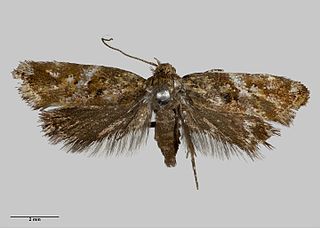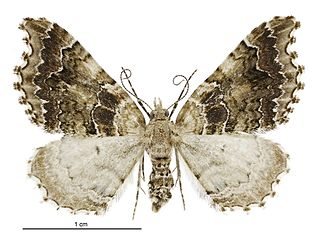Helcystogramma lithostrotum is a moth in the family Gelechiidae. It was described by Edward Meyrick in 1916. It is known from Malaysia.
Epermenia ellochistis is a moth in the family Epermeniidae. It was described by Edward Meyrick in 1917. It is found in Assam, India.
Dichomeris ferrata is a moth in the family Gelechiidae. It was described by Edward Meyrick in 1913. It is found in Assam, India.
Aeolotrocha generosa is a species of moth in the family Gelechiidae. It was described by Edward Meyrick in 1921. It is found in South Africa.
Leuronoma oenochyta is a moth of the family Gelechiidae. It was described by Edward Meyrick in 1921. It is found in Zimbabwe and Namibia.
Compsosaris testacea is a moth in the family Gelechiidae. It was described by Edward Meyrick in 1914. It is found in Guyana.
Aristotelia probolopis is a moth of the family Gelechiidae. It was described by Edward Meyrick in 1923. It is found in Peru and Amazonas, Brazil.
Autosticha pelaea is a moth in the family Autostichidae. It was described by Edward Meyrick in 1908. It is found in Sri Lanka.
Orphnolechia acridula is a moth of the family Depressariidae first described by Edward Meyrick in 1918. It is found in French Guiana.
Lecithocera amphigrapta is a moth in the family Lecithoceridae. It was described by Edward Meyrick in 1926. It is found on Borneo.
Deltoplastis cremnaspis is a moth in the family Lecithoceridae. It was described by Edward Meyrick in 1905. It is found in Sri Lanka.
Deltoplastis caduca is a moth in the family Lecithoceridae. It was described by Edward Meyrick in 1910. It is found in Assam, India.
Symphorostola encomias is a moth in the family Xyloryctidae, and the only species in the genus Symphorostola. Both species and genus were described by Edward Meyrick in 1927. The species is found on Sumatra.
Aeolanthes deltogramma is a moth in the family Depressariidae. It was described by Edward Meyrick in 1923. It is found in India (Assam).
Psittacastis gaulica is a moth in the family Depressariidae. It was described by Edward Meyrick in 1909. It is found in Bolivia.
Psittacastis molybdaspis is a moth in the family Depressariidae. It was described by Edward Meyrick in 1926. It is found in Peru.
Imma chlorosphena is a moth in the family Immidae. It was described by Edward Meyrick in 1906. It is found in Sri Lanka.
Moca selenaspis is a moth in the family Immidae. It was described by Edward Meyrick in 1925. It is found on Borneo.

Tingena eumenopa is a species of moth in the family Oecophoridae. It is endemic to New Zealand and found in the North and South Islands. The adults have been found amongst tree ferns and are on the wing in December.

Helastia cymozeucta is a moth of the family Geometridae. It was first described by Edward Meyrick in 1913. This species is endemic to New Zealand and is found in both the North and the upper parts of the South Island. The adults of this species have been observed on the wing from November to January as well as in March.

